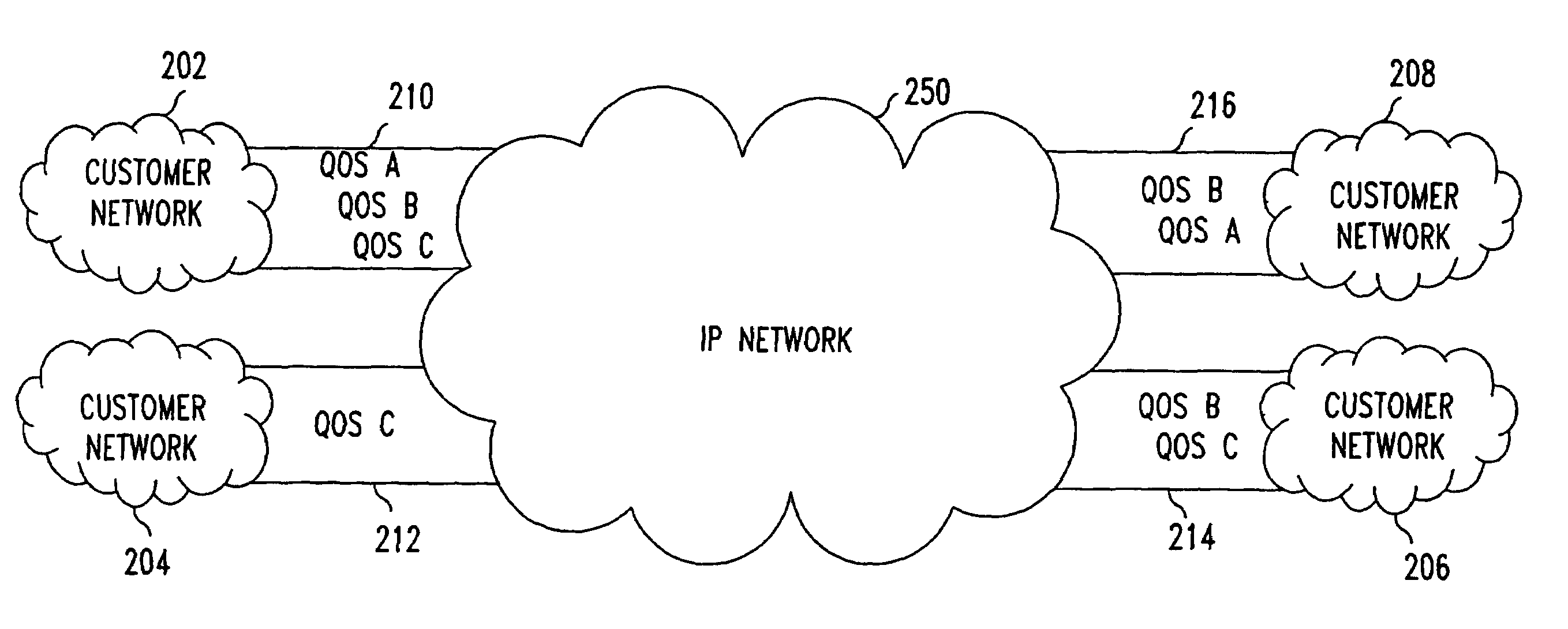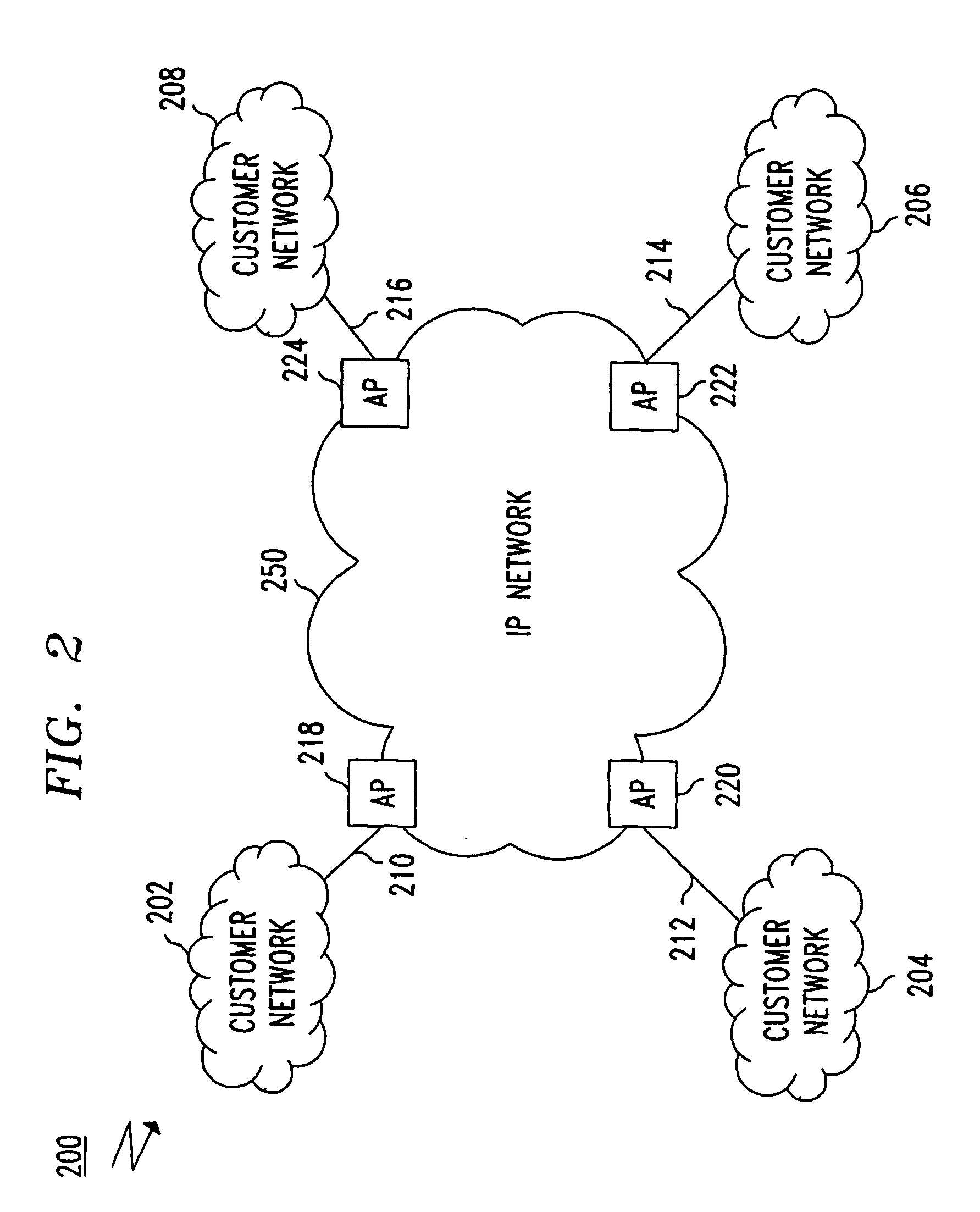Virtual private network
a virtual private network and network technology, applied in data switching networks, frequency-division multiplexes, instruments, etc., can solve problems such as complex interfaces with private line networks, achieve network resource allocation efficiency, and achieve significant gains
- Summary
- Abstract
- Description
- Claims
- Application Information
AI Technical Summary
Benefits of technology
Problems solved by technology
Method used
Image
Examples
case 1
[0035]In case 1, the customer may manage the outgoing hose traffic by controlling the rate of data packets output through the hoses 210–216 from different applications based on a priority scheme. Thus, higher priority applications may output more data packets than lower priority applications. After the data packets enter the hoses 210–216, the data packets are not distinguished from each other but are only identified by a VPN identification (ID), for example. Thus, for case 1, the VPN service provider does not distinguish one data packet from another within a single VPN, but only distinguishes one VPN from another. Thus, for case 1, the VPN service provider may only take advantage of potential multiplexing opportunities based on a single effective bandwidth hose profile. Other techniques may also be used such as weighted fair queuing so that different applications within the customer network may be assigned different weights and data packets from each application are allocated bandw...
case 2
[0037]In case 2, the customer manages the communication traffic through the hoses 210–216 by marking individual data packets. For example, each data packet is marked corresponding to the QOS assigned to the corresponding application. All the marked data packets are output to the hoses 210–216 and the VPN service provider processes the data packets based on the mark of each data packet. The VPN service provider will process all the marked data packets up to the hose profile. Data packets output through the hoses 210–216 that exceed the hose profile, may be dropped or handled in a best effort manner which may be specified in the hose profile.
[0038]FIG. 3 shows a diagram illustrating a VPN having customer managed hoses. Each of the customer networks 202–208 may independently define the hose profile for its respective hose 210–216. For example, the customer network 202 has a hose profile that has requirements for QOS A, QOS B and QOS C data packets while the hose profile for the hose 21...
case 4
[0040]In case 4, the VPN service provider establishes various VPNs corresponding to the QOS levels required and the customer networks 202–208 mark each of the data packets corresponding to the QOS level. In this case, the VPN service provider honors the markings of the data packets until the hose profile is reached. For example, if the customer network 202 marks a data packet to be QOS A, the VPN service provider transmits the data packet in the QOS A VPN until the QOS A hose profile is reached. QOS A marked data packets that exceed the hose profile may be given lower priority or best effort performance depending on network conditions. In some situations, the hose profile may specify burst traffic conditions where for a prespecified amount of time, the bandwidth may exceed a base level by some predetermined amount. In this situation, QOS level markings of data packets are ignored only when the burst condition parameters of the hose profile are exceeded. Thus, the VPN service provide...
PUM
 Login to View More
Login to View More Abstract
Description
Claims
Application Information
 Login to View More
Login to View More - R&D
- Intellectual Property
- Life Sciences
- Materials
- Tech Scout
- Unparalleled Data Quality
- Higher Quality Content
- 60% Fewer Hallucinations
Browse by: Latest US Patents, China's latest patents, Technical Efficacy Thesaurus, Application Domain, Technology Topic, Popular Technical Reports.
© 2025 PatSnap. All rights reserved.Legal|Privacy policy|Modern Slavery Act Transparency Statement|Sitemap|About US| Contact US: help@patsnap.com



